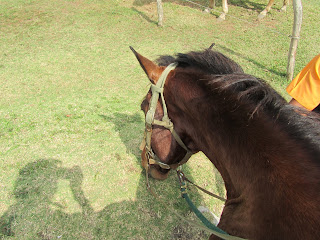Before the holiday craziness I had the opportunity to hear a very interesting presentation by the equine dentist I use. Since Pippin has poor teeth I've learned a lot from him already, but the dentist had so much more to say. I thought I'd share a bit of what I remember with you. But, since I am somewhat 'long in the tooth'* myself, I may not remember it all!
* Since horses teeth continue to erupt and the incisors appear to grow longer as the horses age, this idiom came to mean growing older!
Horses, like humans, begin their early life with baby teeth, also called deciduous teeth. The baby teeth are shed beginning around 2 years of age and will continue to about 4 1/2 years. The roots of the baby teeth disintegrate and the top of the tooth, or cap, remains on top of the erupting adult tooth until it falls off. Sometimes a permanent tooth will erupt and push the cap aside, but it won't completely fall out. This can cause a problem with the position of the permanent tooth or the horse's bite. It is important to have a young horse's teeth checked frequently, maybe as often as every four months, while he is shedding his baby teeth.
This image shows retained incisors on a 2 1/2 year old horse.
 |
| http://www.evdsdentalinstruments.com/site/index.php?section=90 |
The caps are very sharp and have ulcerated the horse's lip, causing him pain. If the caps are not removed the permanent teeth will not align properly.
Unlike rodents, horse teeth do not actually continue to grow. When they are formed the tooth is 4 inches or slightly longer in length. The majority of the crown of the tooth is in the jaw below the gum line, with only about 1/2 inch being visible in the horse's mouth. The tooth surface wears down from chewing and the tooth continues to erupt throughout the horse's life. As the horse ages, less of the crown of the tooth is under the gum line. Older horses may lose their teeth as after many years the crown may be totally worn away.
This is Pippin's molar. It was extracted last year because it had abscessed. For some reason Pippin never formed cementum in the folds of his teeth, so bacteria from decomposing food caused decay and ultimately infection. The true root of the tooth is the last 1/4" on the right. The clean section of the crown, about 3/4" on the left, is all that was showing above the gum line.
Like humans, horses have incisors in the front. These are the cutting teeth. Behind the incisors the horse may have a canine tooth on each side, top and bottom. These are often not found in mares. After a space, which we call the bar of the mouth, the horse will have 3 premolars and 3 molars on each side of the jaw, top and bottom. Occasionally a horse will have one or more small teeth called "wolf teeth" snuggled next to the molars. These are often removed as they may cause bitting problems.
After all permanent teeth are in place horses should have their teeth examined at least once a year. This examination should be more than a veterinarian taking a quick peek in the front and sticking his hand to the back of the horse's mouth to feel for sharp areas. It is critical that the veterinarian (or equine dentist) use a speculum and a flashlight or head lamp to be able to see all the way into the back of the mouth.
 |
| The dental assistant fits the speculum on Doc. |
The specialist should also use a mirror to examine the biting surface of the molars to look for cavities or cracked teeth and to check the gums, tongue and cheeks for irritation or lacerations.
The teeth of a horse need to be aligned to allow the best possible grinding action. If teeth are unevenly worn they may not only develop sharp spots that can lacerate the cheeks, gums or tongue of the horse, but they may limit the movement of the horse's jaw, either sideways or from front to back.
This is one type of a 'hook'. The hook is sharp and can cut the gums as well as limit movement of the jaw forward and backward.
Click here for more images of dental problems.
The undulating shape of the teeth in this image form a wave. Again, this limits the movement of the jaw and would cause poor grinding of food. Additionally, pressure points and areas where food can become impacted could cause damage to other teeth and infection.
Incisors may have problems as well. If the incisors become too long, the molars may not even meet, and thus may not be able to grind the food adequately for proper nutrition. Inattention to the teeth over a long period of time could lead to malocclusion that causes an overbite or an underbite, making it difficult for horses to graze. (An overbite or underbite could also be a congenital problem caused by the length of the jaws.) With proper attention and corrective floating, this type of problem can be lessened, if not alleviated over time.
If the molars develop waves or hooks that force the horse's jaw in an unnatural position the bite may not be straight.
A veterinarian or an equine dentist can float the teeth to bring them into alignment, create a smooth biting surface and allow the jaw to move in all directions. Dental health is as important for horses as it is for us. And the saying, "An ounce of prevention is worth a pound of cure" couldn't be more appropriate when it comes to your horse's dental health.


















































